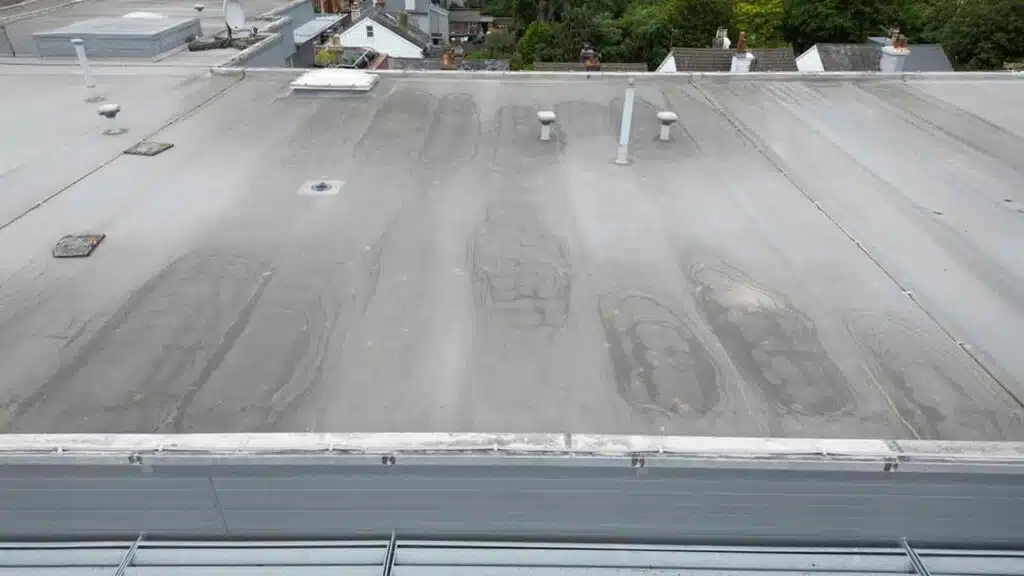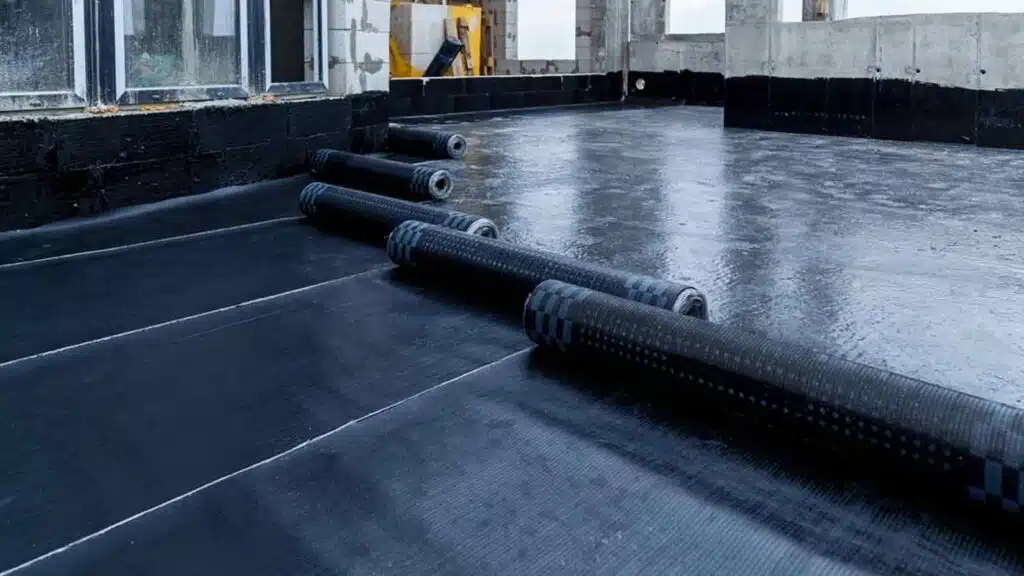The Benefits of Flat Roofing: Is It the Right Choice for Your Home?

Imagine a sleek, modern roofline, a vast expanse of space ready to be utilized. Flat roofs, once relegated to commercial buildings, are increasingly finding their place atop homes and businesses across the US. But are they the right choice for your specific needs? This blog dives into the world of flat roofing, exploring its benefits, drawbacks, and suitability for various applications, so you can find the best option for roof installation and roof repair.
Table of Contents
- What is Flat Roofing: Types, Materials, Benefits, & Features Explored
- Discover the Benefits: Why Flat Roofs are Ideal for Homeowners Now
- Flat Roof Materials Guide: Choosing the Best Option for Your Building
- Flat Roof Problems: Maintenance Tips and Repair Solutions Detailed
- Flat Roofing Costs: Understanding Expenses for Installation & Repairs
- Flat vs. Sloped Roofs: Which Option is the Best Choice for You Here?
- Long-Lasting Roof: Essential Flat Roof Maintenance Tips & Practices
- Flat Roofing Professionals: Choosing a Qualified Contractor Near You
- Making the Right Choice: Is Flat Roofing Best for Your Property Now?
- Frequently Asked Questions: Your Top Flat Roofing Questions Answered
What is Flat Roofing: Types, Materials, Benefits, & Features Explored
Flat roofing, despite its name, incorporates a slight pitch for water runoff, essential for preventing ponding and water damage. This subtle design feature ensures its practicality for both residential and commercial buildings. Understanding the various flat roofing systems available is key to making an informed decision, as selecting the proper materials can drastically affect the longevity of your roof and the need for roofing services.
Here’s a look at some common flat roofing materials:
- Built-Up Roofing (BUR): Layers of asphalt and fabrics. Durable but heavy.
- Modified Bitumen: Flexible asphalt with polymers. Easier to install than BUR.
- EPDM (Rubber): Long-lasting, weather-resistant. Needs careful seam sealing.
- TPO (Thermoplastic): Reflective, energy-efficient. Heat-welded for watertight seals.
- PVC (Polyvinyl): Durable, chemical-resistant. More expensive option.
Your choice depends on your budget, climate, building structure, and desired lifespan, impacting the need for future roof repair near Boston. Selecting the right flat roof material is important for long-term health and maximizing benefits. Consider each material’s pros and cons to make an informed decision.
Discover the Benefits: Why Flat Roofs are Ideal for Homeowners Now
Flat roofs provide many advantages, attracting residential and commercial property owners looking for modern and efficient solutions. While they may not be as visually stunning as sloped roofs, their practical benefits are significant. Flat roofs can offer everything from cost savings to increased usable space, making them a worthwhile investment. Consider the benefits, especially if you’re comparing roofing companies near Boston.
Here are key benefits of flat roofs:
- Cost-Effective Installation: Less material and labor compared to sloped roofs.
- Increased Usable Space: Rooftop garden, patio, or solar panel installation possible.
- Easy Accessibility: Simplified maintenance, repairs, and inspections.
- Modern Aesthetic: Sleek, contemporary look, enhances curb appeal.
- HVAC Efficiency: Can improve insulation and reduce energy consumption.
Businesses use flat roofs for HVAC systems, maximizing interior space and allowing for better access. Homeowners enjoy rooftop oases and appreciate the clean lines of a flat roof house. These benefits are worth considering when choosing your next roofing project.

Flat Roof Materials Guide: Choosing the Best Option for Your Building
Selecting the right material is essential for the longevity and performance of your flat roof, impacting everything from energy efficiency to maintenance requirements. Each option has advantages and disadvantages, and what best suits you will vary. This guide offers valuable insights if you want to explore more affordable solutions with easy access to future flat roof repair.
Here’s a deeper look at flat roofing materials:
- Built-Up Roofing (BUR): Long-standing, durable. Requires specialized installation.
- Modified Bitumen: Flexible and weather-resistant. Easier install than BUR.
- EPDM: Durable and cost-effective. Long lifespan; needs careful seam sealing.
- TPO: Reflective, lowers energy costs. Heat-welded seams ensure water tightness.
- PVC: Durable and chemical-resistant. Suitable for industrial applications.
Consider long-term costs, maintenance, and environmental impact to make the best decision. Investing wisely ensures long-term benefits for your property and limits future roof repair. Make sure to do your research on the available options.
Flat Roof Problems: Maintenance Tips and Repair Solutions Detailed
While offering many benefits, flat roofs have potential problems that need to be addressed, often stemming from their unique design. Early issue identification and preventive measures are vital to avoid costly repairs and long-term damage. That’s why having a reputable company perform regular gutter cleaning service is essential.
Common flat roof problems include:
- Ponding Water: Poor drainage damages roofing material over time.
- Leaks: Cracks and poorly sealed seams cause leaks. Prompt roof leak repair is essential.
- Blistering: Trapped moisture forms blisters, weakening the material.
- Membrane Damage: UV rays, temperatures, and traffic harm the membrane.
- Gutter Issues: Clogged gutters cause ponding and potential damage.
Addressing issues quickly saves money on potential flat roof repair and protects your property. Minor repairs may need roofing cement and a utility knife, while larger issues require professional help, which is worth considering.
Flat Roofing Costs: Understanding Expenses for Installation & Repairs
The cost of flat roofing varies based on material, roof size, and installation complexity. Careful financial planning, by considering all the potential expenses, is crucial when planning for your new roof. Remember to factor in skylight repair costs if adding skylights, as these may need extra maintenance.
Here’s an estimated cost overview:
- Installation: $5-$15/sq ft, depending on the material.
- Repairs: $100-$500 for small leaks.
- Replacement: $5,000-$20,000+, based on size and material.
Please, take into consideration that it is important to check the prices with contractors individually will give you the best idea on your roofing costs.
Quality materials and professional install minimize long-term costs, so ensure your roofing services are the highest quality. Get quotes from roofing companies near Boston for transparent and fair pricing. CAN Roof provides transparent pricing for our flat roofing services, ensuring you are well informed from start to finish.

Flat vs. Sloped Roofs: Which Option is the Best Choice for You Here?
Choosing between flat and sloped roofs depends on individual needs and preferences, as each offers advantages and disadvantages that need to be considered. Ultimately, the “best” choice is subjective, depending on factors like climate, budget, and aesthetic desires. Think about roof replacement options before deciding, as the decision will influence the long-term maintenance needs of your home.
Compare flat and sloped roofs:
- Cost: Flat roofs are often cheaper to install.
- Space: Flat roofs offer usable space.
- Aesthetics: Sloped roofs are visually appealing, while flat roofs can offer a modern look.
- Maintenance: Flat roofs require more frequent upkeep.
- Climate: Sloped roofs shed snow and ice better in cold climates.
Sloped roofs often suit snowy areas, while flat roofs are practical for equipment housing and better access, so weigh your options carefully. The right decision depends on your circumstances, and selecting between the two is a personal choice.
Long-Lasting Roof: Essential Flat Roof Maintenance Tips & Practices
Proper maintenance significantly extends the lifespan of your flat roof and prevents costly repairs in the future. Regular inspections and proactive measures are essential for identifying and addressing problems early, especially when compared to a traditional design. Remember that proper gutter installation and maintenance are also key to preventing water damage and other common issues.
Follow these maintenance tips:
- Regular Inspections: Inspect twice a year, and after storms.
- Clear Debris: Remove leaves, branches, and debris.
- Check for Ponding: Address areas where water pools.
- Seal Seams and Cracks: Repair material cracks.
- Trim Overhanging Trees: Cut branches that could damage the roof.
Following these steps ensures your flat roof stays in good condition and avoids costly roof repair. CAN Roof offers maintenance plans to protect your investment and keep your roof in excellent condition.

Flat Roofing Professionals: Choosing a Qualified Contractor Near You
Choosing the right contractor ensures a quality install or repair for your flat roof, as it can be a complicated process requiring specialized skills. Look for experience, a good reputation, proper licensing, and insurance when selecting a professional. Remember that finding a good contractor can also help with future roof repair near Boston, guaranteeing the long-term health of your roof.
Tips for finding a qualified contractor:
- Check Licensing: Ensure the contractor is licensed in your state.
- Ask for References: Speak to past customers about work quality.
- Read Reviews: Check online review sites.
- Get Quotes: Compare prices from several contractors.
- Ask About Warranties: Ensure warranty on their work.
CAN Roof is a trusted flat roofing contractor in Boston that provides quality work at competitive prices.
Making the Right Choice: Is Flat Roofing Best for Your Property Now?
Flat roofs provide cost-effectiveness, usable space, and modern appeal for both residential and commercial structures. While they require regular maintenance and are not suited for every climate, they’re often a great choice for many property owners. If you’re considering a new roof or roofing replacement, explore the possibilities of a flat roof for your building!
Consider your needs, budget, and climate when deciding, and make sure it suits the needs of your home and family. The best roof provides lasting protection, function, and appeal, while fitting your aesthetic preferences.
If you’re in Boston and considering a flat roof, CAN Roof is here to help! Contact us for a free consultation and quote today! Protect your home with CAN Roof, today!
Frequently Asked Questions: Your Top Flat Roofing Questions Answered
How long do flat roofs last?
With proper maintenance, a flat roof typically lasts 20-30 years, or even longer, providing lasting value. The exact lifespan depends on material and local climate conditions. Consistent care ensures years of reliable protection.
Are flat roofs more prone to leaks than sloped roofs?
Not necessarily, but they require careful installation and more consistent maintenance to prevent issues with water pooling, particularly in areas with heavy rainfall. Ensuring proper drainage is critical for maintaining the health of the roof. Addressing these concerns early ensures lasting protection.
Can I install a flat roof myself?
Minor repairs can be DIY projects, but it’s generally recommended to hire a professional for flat roof installation or replacement for safety. This ensures proper installation, avoids potential water damage, and keeps your house safe for years to come. Consider contacting us to find out more!
What are the advantages of a green roof on a flat roof?
Green roofs insulate buildings, reduce stormwater runoff, improve local air quality, and can create a beautiful outdoor space for enjoyment. This eco-friendly option is becoming increasingly popular, especially as it provides homeowners with beautiful spaces. Consider installing a green roof on your next flat roof to get these great benefits.
How do I prevent ponding water on my flat roof?
Ensure proper drainage by regularly cleaning gutters and addressing low spots on the roof with repairs. Tapered insulation is a good option as it effectively minimizes any water accumulation. Regular maintenance will go a long way in preventing pondering.
